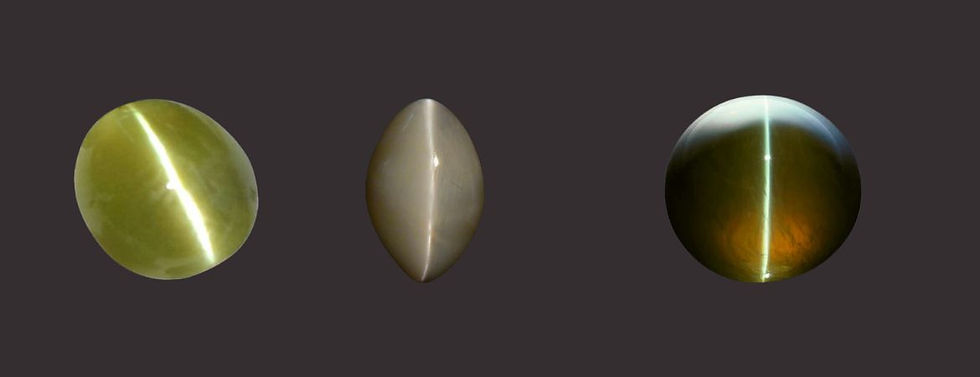
Image credit to Geologyin
Intrigued by gemstones with a hidden light? Have you ever been captivated by a gemstone that seems to hold a mysterious light within? That captivating, silky sheen that dances across its surface like a watchful cat's eye is a fascinating phenomenon called chatoyancy. Here at Gemguru.sg, our gemologist Howe Wei can shed some light on the science behind this mesmerising effect!
The Science Behind the Shine of Chatoyancy
The word "chatoyancy" comes from the French "oeil de chat," meaning "cat's eye." This aptly describes the effect, which occurs due to the presence of tiny, parallel, hollow tubes or fibers within a gemstone. These microscopic structures, often referred to as "silk," act like miniature light guides. When light hits the gem, it travels through these tubes and reflects off their walls, concentrating into a beam that appears as a luminous band across the stone's dome.

Image credit to Pat Daly - Gem-A
What is chatoyancy in gemstones?
Chatoyancy, also known as the "cat's eye" effect, is an intriguing optical occurrence observed in specific gemstones. This phenomenon showcases a radiant band of light that glides across the gem's surface when rotated under a light source. This captivating effect mirrors the reflection of light from a cat's eye, hence its name.
Here's a breakdown of the factors that lead to chatoyancy:
Inclusions:
The process commences with minute, parallel inclusions within the gemstone, which may take the form of hollow tubes, needle-like crystals, or fractures.
Light Reflection:
When light penetrates the gemstone, it enters these parallel inclusions and bounces off their walls.
Concentrated Beam:
Thanks to the parallel alignment of the inclusions, the reflected light converges into a singular beam, producing the luminous band that traverses the stone's surface.

What is an example of chatoyancy?
An excellent demonstration of chatoyancy, from which the term originates, is a cat's eye.
Visualise holding a cat to the light and observing its eye. You will notice a bright vertical slit in the center of the pupil, reflecting light. This distinct line is a result of how light interacts with the fibers in the cat's iris.
In gemstones showcasing chatoyancy, a similar effect occurs. Small, parallel inclusions within the stone function akin to the fibers in a cat's eye, reflecting light and producing a single, focused band that moves across the gem's surface as it is rotated under a light source.

Image credit to gemstones (quora), indiamart.com
Gemstones with Cat's Eye Magic
Several gemstones can exhibit chatoyancy, but some are more renowned for it than others. Here are a few of the most popular:
Chrysoberyl: Chrysoberyl is one of the most prized gemstones to exhibit chatoyancy, and is sometimes referred to as cymophane, which comes from the Greek words for "wave" and "to appear" because of the way the light plays across the stone. When referring to a cat's-eye stone, it is usually understood to be a chrysoberyl unless otherwise specified. Chrysoberyl cabochons can range in color from yellow-green to golden yellow to a more greenish hue. The finest chatoyancy will appear as a sharp, single band of light that moves across the surface of the stone as it is turned.Chrysoberyl is a relatively hard gemstone (8.5 on the Mohs scale), making it durable for use in jewelry. It is a relatively rare gemstone, and cabochons with excellent chatoyancy can be quite valuable.
Tiger's Eye: Formed from crocidolite quartz, the tiger's eye showcases a chatoyancy that often appears as a golden brown band against a chatoyant, silky luster.
Tourmaline: Certain varieties of tourmaline, particularly green cat's-eye tourmaline, exhibit captivating chatoyancy that adds depth and intrigue to the gem.
Scapolite: This lesser-known gem can display beautiful chatoyancy in shades of yellow, green, and even violet.
Pietersite Cabachon: Pietersite cat's eye effect exhibits a luminous band that moves across the stone when rotated under light. Tiny inclusions within the gem reflect light, creating this captivating play. Available in brown, red, orange, and even yellow, green, and blue, Pietersite's strong chatoyancy makes it a popular gemstone for jewelry.
Cutting for the Cat's Eye Effect
To best showcase chatoyancy, lapidaries (gem cutters) employ a specific cutting technique called cabochon. This dome-shaped cut, with a flat base, allows light to interact with the parallel inclusions within the gem, maximising the cat's eye effect.
The Value of Chatoyancy
Chatoyancy can significantly enhance a gemstone's value. A well-defined, sharp cat's eye effect adds a unique dimension of beauty and intrigue to the gem, making it highly desirable for collectors and jewelry enthusiasts.

Image credit to indiamart.com
Beyond the Cat's Eye: A Collector's Delight
Gemstones with chatoyancy offer a captivating interplay of light and texture. Whether it's the luxurious sheen of chrysoberyl, the earthy charm of tiger's eye, or the unexpected beauty of scapolite, these gems possess a magic that goes beyond their inherent color. So, the next time you encounter a gemstone with a captivating cat's eye effect, take a moment to appreciate the wonder of nature's light show!
Want to learn more about the fascinating world of chatoyancy? Our gemologists at Gemguru.sg are here to answer your questions. Get in touch today!
Comentarios